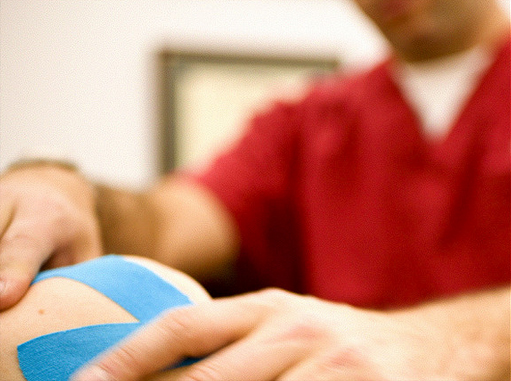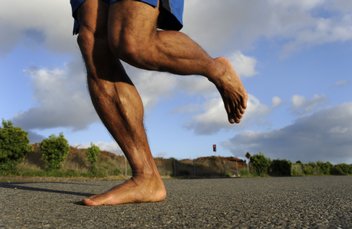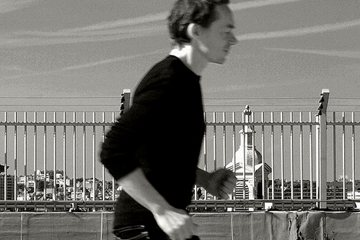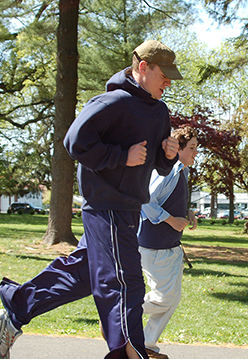Today, running is one of the preferred forms of exercise because it doesn’t require too much equipment and money, plus it can be done almost anywhere. It is also relatively safe to do, but runners can still get injuries, particularly knee pain. Medically, it is called Patellofemoral pain syndrome, which usually begins with mild pain below the kneecap and progresses to a more intense painful feeling while running and even while at rest. Patellofemoral pain syndrome exercises and other tips can be done to beat knee pain from running.
The first thing a runner with knee pain can do is to take a break from running. Ice the injured knee for 10 to 20 minutes while resting or if a doctor prescribes it, take some pain or anti-inflammatory medicine. Basically, the aim is to decrease the stress on the knees so they can heal quickly. As they get better, do not engage in extreme running right away; a gradual increase in running time and mileage should be practiced and choose softer places to run in.
Aside from light running, one can still do other exercises while waiting for the knees to recover fully. There are certain Patellofemoral pain syndrome exercises that can be done twice a day, but only for a few minutes. Some of these exercises include the following:
1) Hamstring stretches can be done with or without a chair. If you’re using a chair or bench, place one of your heels on it. Straighten your back and lean forward from your hips until a stretch at the back of your leg is felt. Hold the stretch for about a minute and switch sides. Alternatively, you can simply lie on your back, bend a knee, grip & steady the thigh, and straighten the leg until a stretch is felt. Hamstring stretches can be done 5-10 times for each side.
2) Quadriceps strengthening exercises can also be done in 2 ways: isometrics and straight leg lifts. Isometric quad exercises concentrate on the thigh muscles by contracting them while ensuring little or no movement in the knee joints. Straight leg lifts also don’t make use of the knees much as the legs are the ones lifted. These exercises should be done while lying face upward and the elbows can be used for support.
3) Hip and buttock stretches are also recommended. In a very straight sitting position, one leg must be under the other leg while positioning your hands on the knee that’s currently on top. Slightly pull that knee toward you and hold that position for around 20 seconds then switch sides.
When experiencing knee pain from running, another thing to consider is your choice of shoes. Make sure that your running shoes have ample arch support, particularly if you are flat-footed. Running shoes that do not match your gait and foot type can cause much stress to your knees and may also lead to other injuries.
Generally, to beat knee pain from running, you must refrain from bending or moving the injured knee/s too much. Coupled with Patellofemoral pain syndrome exercises, your knees will soon be back in shape.
Have you suffered from knee tendonitis before? If you have experienced knee pain from running because of this, there’s a good chance that it could affect you again, especially if you are a regular runner.
If you want to keep on running, it’s important to take care of your knees so that these specific parts of your body will not be prone to injuries. Patellofemoral pain syndrome exercises will help along with extra precautionary measures.
Running and Healing When You Have Knee Tendonitis
In order to understand the seriousness of the situation, imagine the internal components of your knees and picture the bones, joints, muscles, tendons, and ligaments. Yes, it’s really a complex structure; and when one part gets damaged, the whole knee mechanism will be affected.
When you have knee tendonitis, the tendons on your knees are either strained or damaged. And the damage, of course, will depend on your particular condition.
Needless to say, the healing process can take some time, especially when ample rest is not taken. Although minor cases won’t restrict you from moving and carrying on with your daily activities, it is not recommendable to go back to running sessions if you are still recuperating from the injury. Doing so can even worsen a mild case of strain and result in a completely torn tendon.
The Risks of Running When You Have Knee Tendonitis
If you are constantly suffering from knee pain from running because you have knee tendonitis, it would be risky to continue with the activity. If your knees are too painful for you to jog, run, or go into training sessions, then don’t do it.
Know that forcing yourself to perform running activities, no matter how low impact these may be, can lead to further damage. Not putting off a week of practice can really immobilize you for months, or even longer.
So at this point, resting and performing patellofemoral pain syndrome exercises are more advisable as said routines can help your knees heal faster. And that will put you back into the running field faster too.
Check Your Weight
Believe it or not, your body weight also plays a role on your vulnerability to having knee tendonitis and other knee problems. Your legs are carrying your whole weight; and this can prove to be particularly stressful for your joints and muscles.
So if you are overweight and prone to knee injuries, consider shedding off some pounds. This will be good for your knees, legs and feet and overall health too.
Preventing Knee Pain and Injuries
Always make it a point to warm up before any running and training activities as this will put your body in a perfect condition for the task. Allotting around 10 to 20 minutes for stretches and warm up procedures will lessen the chances of having joint and muscle pain.
If you can choose the place to hold your running exercises, it would also be wise to opt for grassy spots over hard pavement. And choose shoes that can also provide your feet with cushions so that landing on the ground will not be as stressful to your knee joints. You shouldn’t neglect your patellofemoral pain syndrome exercises too, as these can help you avoid knee pain from running.
How to Diagnose Patellofemoral Pain Syndrome
Patellofemoral Pain Syndrome (PFPS) can cause knee pain from running. This is a common problem; and if the symptoms are minor, the pain will usually go away naturally just by resting from strenuous activities. Patellofemoral pain syndrome exercises are also recommended.
However, worse cases of PFPS can be debilitating, as it can be hard to move around when one is in pain especially when it affects the knee joints. So if you notice that your symptoms are persistent and progressive, it would be good to seek medical attention so that the problem can be treated properly.
Diagnosing PFPS
 Your doctor would want to know everything about the history of your knee problem so as to come up with an accurate diagnosis; so be prepared to answer important questions about your particular ailment.
Your doctor would want to know everything about the history of your knee problem so as to come up with an accurate diagnosis; so be prepared to answer important questions about your particular ailment.
One of the first things that your doctor would like to know is when the problem first came about. You should also inform the attending physician of any existing knee problems, especially if you have had knee or leg surgery before.
Your knee area will also be checked to see if there is any tenderness, swelling, and pain. Your doctor may even move your patella or kneecap so as to check for proper tracking as this could also be the cause of your knee problem.
A thorough check up will also rule out side effects from allergy and sugar problems. And if you are taking medications for other health problems, this will be taken into consideration too.
Tests for Knee Problems
Diagnosing PFPS, knee pain from running, or runner’s knee can include x-ray tests so as to be able to look at the knee structure from different angles. This type of test can also confirm if your patella (knee cap) is out of track.
Magnetic Resonance Imaging (MRI) can also be recommended by your doctor so as to see the detailed composition of your bones and cartilages. Muscle problems can be seen through this type of test too.
Going through Arthroscopy procedure is another option; and in this test, a small camera needs to be inserted inside the knee area so as to see the inside structure of your affected knee. This is an outpatient procedure.
What If It’s Patellofemoral Pain Syndrome?
If you are diagnosed with PFPS, your doctor will recommend treatment options for your particular case. You can expect recommendations on carrying out patellofemoral pain syndrome exercises such as those that particularly target the quads. Basically, performing leg exercises will help strengthen your muscles and joints so as to provide stability to your knee structure.
If the cause of your knee problems is poor tracking, knee support devices such as braces and sleeves may be recommended by your doctor. Fortunately, surgery is seldom recommended for cases of patellofemoral pain syndrome.
So if you are often experiencing knee pain from running, you can try managing the problem by performing stretches and patellofemoral pain syndrome exercises. Getting a formal diagnosis from you doctor is also highly recommended.
Can Barefoot Running Help With Knee Pain?
 As a lot of people experience knee pain from running when they’re wearing the wrong type of shoes, a new method of running is becoming more and more popular – barefoot running. But can such an approach really reduce the chances of suffering from knee and foot injuries?
As a lot of people experience knee pain from running when they’re wearing the wrong type of shoes, a new method of running is becoming more and more popular – barefoot running. But can such an approach really reduce the chances of suffering from knee and foot injuries?
Some medical practitioners claim that running without any shoes is an effective way of dealing with leg problems and particularly knee pain. One of the main reasons for such claim is the obvious fact that going barefoot is a natural undertaking and natural means often carry a lot of health benefits.
When you run barefoot it will involve natural joint mechanics as your feet and legs won’t be restricted in any way by a footwear. But this is only applicable to those who don’t have any issues or foot ailments as there are running shoes that are specifically intended to help certain cases of leg and foot problems.
Disadvantages of Barefoot Running
Running barefoot can really prove to be helpful to sufferers of knee pain as this technique can really ease the pressure on the knee joints. However, as the load on the knees is reduced, the stress and pressure from running will be distributed to other parts of the body, particularly on the feet and ankles.
The ankle is also a vulnerable area for sprains and other types of injuries; that’s why running shoes are especially designed and cushioned to protect this particular part of the foot. So by running barefooted you can increase the risk of injuring your feet.
Can Knee Pain From Running be Resolved by Going Barefoot?
Although there are some positive results from the tests conducted on barefoot running as it relates to the management of knee pain, said studies can’t be deemed conclusive as of this date. The reason for this is that no sufficient studies have been made on the subject; and therefore, no conclusive evidences can also support the claim 100%.
Patellofemoral Pain Syndrome Exercises Vs Barefoot Running
Another effective solution to knee pain from running involves using patellofemoral pain syndrome exercises that involve stretches and specific forms of workout techniques. The methods mainly target on putting tension on the muscles during the exercises so that it can result in stronger and more supportive structure for the knees.
Employing exercise techniques have been proven to be more effective than barefoot running; and when done correctly, it can even help in the rehabilitation process of knee injuries. A lot of doctors recommend patellofemoral pain syndrome exercises as treatment procedure for sufferers of knee pain; and it’s also considered to be a preventive measure for other types of leg problems.
If you are going to consider barefoot running as a solution to your knee problems; be sure that you are aware of its many disadvantages too. For one, running barefoot leaves your feet unprotected; and that means you are exposed to being wounded and hurt as you run on unfamiliar surfaces and unknown places.

